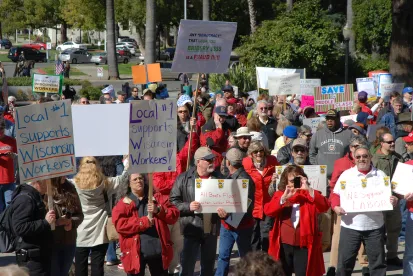An age old question under the National Labor Relations Act is what constitutes “picketing”? By the Supreme Court’s definition, picketing is inherently coercive and may not be directed against a neutral employer. An issue that has vexed employers for the last several years has been the use of stationary protests, such as inflatable rats and banners, calling out neutral companies for doing business with the employer. For approximately 10 years, which in recent Board history is as longstanding as precedent gets, the Board has ruled that such stationary protests are not coercive and, therefore, not unlawful under the Act.
As foreshadowed by the NLRB’s Division of Advice last year, the Board, on October 27, 2020, published a notice and invitation to file briefs addressing issues concerning the legal standard applicable to unions’ use of the most recognizable signs of unionism and labor disputes in urban areas today – inflatable rats and banners. The practice is so common that it spawned a new verb: bannering.
Background
Section 8(b)(4)(i) of the NLRA prohibits labor organizations, or their agents, from inducing or encouraging secondary (i.e., neutral) employees from participating in certain prohibited activities, and Section 8(b)(4)(ii) protects secondary employers from threats, coercion or restraint.
In 2019, in International Union of Operating Engineers, Local Union No. 150 a/w International Union of Operating Engineers, AFL-CIO and Lippert Components, Inc., Case No. 25-CC-228342, 370 NLRB No. 40 (2020), an Administrative Law Judge (“ALJ”) found that the Union’s stationary display of a 12-foot inflatable rat and two large banners, which read “OSHA Found Safety Violations Against [the Primary Employer]” and “Shame on [a Neutral Employer] for Harboring Rat Contractors,” did not amount to picketing or coercive non-picketing conduct under the NLRA.
The ALJ relied on two cases, Eliason & Knuth of Arizona, 355 NLRB 797 (2010) and Brandon Regional Medical Center, 356 NLRB 1290 (2011), in making her decision.
- In Eliason, the NLRB found that the display of large, stationary banners, which announced a labor dispute, shamed the neutral employer and urged the public not to patronize the neutral employer, did not rise to the level of proscribed picketing because they were neither confrontational (unlike a patrolled picket) nor coercive (e., they did not disrupt or threaten to disrupt the neutral employer’s operations).
- The NLRB found in Brandon Regional Medical Center that the presence of a 16-foot inflatable rat mounted on a trailer on public property outside of the neutral employer’s place of business was not unlawful picketing or otherwise coercive conduct.
In response to the ALJ’s decision, the Board’s General Counsel, consistent with prior advice on the subject, has requested that the NLRB overrule Eliason and Brandon Regional Medical Center because those decisions resulted in narrower definitions of picketing and coercion, created “vague and imprecise” standards, and, according to the General Counsel, strayed from NLRB precedent and Section 8(b)(4) of the NLRA. The General Counsel equates the rat and banner display in this case with classic picketing or coercive conduct that unlawfully pressured the neutral employer to no longer conduct business with the primary employer involved in the labor dispute.
Issues for Consideration by the Board
Parties and amici are invited to file briefs on or before November 27, 2020, to aid the NLRB in its consideration of the following questions:
- Should the NLRB adhere to, modify or overrule Eliason and Brandon Regional Medical Center?
- If you believe the NLRB should alter its standard for determining what conduct constitutes proscribed picketing under Section 8(b)(4), what should the standard be?
- If you believe the NLRB should alter its standard for determining what non-picketing conduct is otherwise unlawfully coercive under Section 8(b)(4), what should the standard be?
- Why would finding that the conduct at issue in this case violated the NLRA under any proposed standard not result in a violation of the Respondent’s rights under the First Amendment?
Member McFerran’s Vigorous Dissent
Member Lauren McFerran dissented, stating that the NLRB should decide this case without comment pursuant to existing law. McFerran asserts that the General Counsel is threatening employees’ First Amendment right to free speech – which affords protection even to speech that is unsettling or offensive in this context – by asking the NLRB to overrule well-established precedent concluding that the use of stationary inflatable rats and banners to publicize a labor dispute is lawful under Section 8(b)(4). In support, McFerran cited numerous NLRB and federal court decisions affirming and applying existing Board precedent, including 12 NLRB decisions since the 2010 Eliason decision where the NLRB has declared stationary banners or inflatables lawful under the Act.
Takeaways
Inflatable rats and banners are a universal protest symbol for labor unions throughout the country, and they are often parked outside of neutral employers’ offices to signal opposition against primary employers and/or non-union contractors with which the labor union has a dispute. Likely due to recent criticism by not accepting comment after overturning well-established precedent, the Board has opened the door to all constituencies to comment on this hotly-contested issue, inviting contemporary interpretation of the scope of picketing and coercive conduct under Section 8(b)(4) of the NLRA. The impact of a potential decision that overturns Eliason and Brandon Regional Medical Center could be significant, in that it may dramatically change the tactics available to unions in exerting pressure on neutral employers in the cross-hairs of a labor dispute. For some short period anyway, maybe even as long as 10 years!





 />i
/>i

